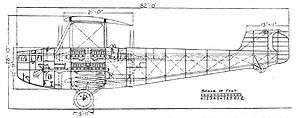DFW R.III
| R.III | |
|---|---|
 | |
| Role | Bomber |
| Manufacturer | DFW |
| Status | Cancelled project |
| Primary user | Luftstreitkräfte |
|
| |
The DFW R.III was a German bomber aircraft designed during World War I, but which had not yet been built when the end of the war led to the project's cancellation. Conceptually similar to DFW's preceding R.I and R.II designs, the R.III was to have been a much larger aircraft, powered by eight engines. As with the previous designs, these were to be housed inside the fuselage, driving propellers by long driveshafts. In the R.III design, however, these propellers were to be mounted on a nacelle in the interplane gap. Each end of this nacelle would carry two co-axial propellers, each driven by a separate engine. Had it been built, the R.III would have been the largest aircraft in the world at the time.
Specifications (as designed)
General characteristics
- Length: 25.00 m (82 ft 0 in)
- Wingspan: 53.50 m (175 ft 6 in)
- Height: 8.78 m (28 ft 10 in)
- Powerplant: 8 × Mercedes D.IVa, 194 kW (260 hp) each
Armament
- 8 × machine guns
- 2,500 kg (5,500 lb) of bombs
References
| Wikimedia Commons has media related to DFW aircraft. |
- The German Giants, The Story of the R-planes 1914-1919, G.W. Haddow & Peter M. Grosz, Putnam & Company Limited, 42 Great Russell Street, London, First Published July 1962
- "The German D.F.W. Commercial Four-Engined Biplane" Flight 25 September 1919, vol. XI, no. 39, pp. 1274–78. The R.III is described and illustrated on pp. 1276–77.
This article is issued from Wikipedia - version of the 6/23/2015. The text is available under the Creative Commons Attribution/Share Alike but additional terms may apply for the media files.
